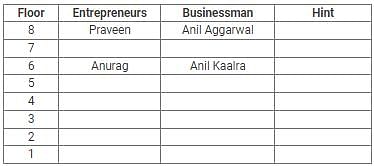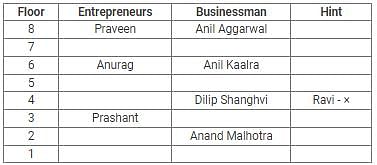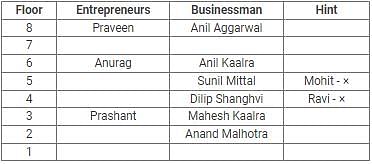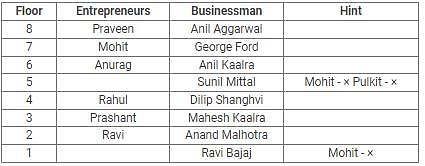SSC CGL (Tier II) Practice Test - 12 - SSC CGL MCQ
30 Questions MCQ Test - SSC CGL (Tier II) Practice Test - 12
Statements :
I. Divya's mother is sister of Shaloo's father.
II. Shaloo is the daughter of Divya's grandfather's only child.
Q. How is Divya related to Shaloo ?
I. Divya's mother is sister of Shaloo's father.
II. Shaloo is the daughter of Divya's grandfather's only child.
An inlet pipe can fill a tank in 4 hours and an outlet pipe can empty a tank in 3/7 of a tank in 3h. Find the time taken to fill the tank if they start working alternately.
The curved surface areas of two spheres are in the ratio of 1 : 4. Find the ratio of their volumes.
Directions : Study the following information carefully and answer the questions given beside.
Virat kohli scored runs against different countries in three different years.
NOTE: Total runs scored in a year= Australia + England + Others
2015: The total runs scored in 2015 were 1200. The runs scored against England were 1/3rd of the runs against Others in 2016. The average runs scored against Australia and England was 300.
2016: The total runs scored against Australia and Others was 1200. The ratio of the total runs scored against Others in 2015 to that of the total runs scored against Others in 2016 is 4:3. The total runs scored against England in 2016 were equal to the total runs scored against England in 2017.
2017: The sum of the total runs scored against Australia and England is equal to the total runs scored against Others. The total runs scored in 2017 were 1400. The total runs scored against Australia were twice of the runs scored against England in 2015.
Q. What were the total runs scored in 2016?
The sum of the square of the three consecutive even natural numbers is 1460. Find the numbers?
For all x, x2 + 2ax + (10 − 3a) > 0, then the interval in which a lies, is?
Directions: Read the given information carefully and answer the questions given beside:
Eight persons are living in an apartment having eight floors. First floor is numbered one; second floor is numbered two and so on till the top-most floor which is numbered eight. There are eight entrepreneurs and eight leading businessmen in the building. On each floor one entrepreneur lives with one leading businessman. The names of the eight entrepreneurs are – Mohit, Ravi, Pulkit, Praveen, Anurag, Nishant, Prashant and Rahul – not necessarily in the same order. The names of the eight businessmen are – Mahesh Kaalra, Sunil Mittal, Anil Aggarwal, Ravi Bajaj, Anand Malhotra, George Ford, Dilip Shanghvi and Anil Kaalra.
Rahul is staying on an even – numbered floor and Ravi Bajaj is staying on the first floor. There are two persons staying between the floors on which Prashant and Anurag live. Praveen is staying on the topmost floor with Anil Aggarwal. Sunil Mittal is staying on the floor exactly below the floor of Anil Kaalra but not with Pulkit. Mahesh Kaalra is staying exactly between the floors of Dilip Shanghvi and Anand Malhotra but not on the fifth floor. Prashant is staying on the third floor. Ravi is staying on an even – numbered floor and Mohit is staying on an odd – numbered floor but not on the first floor. Dilip Shanghvi is staying on the fourth floor but Ravi is not staying with him. Anand Malhotra is staying on the second floor. George Ford and Mohit are not staying on the fifth floor. Anil Kaalra is staying with Anurag on floor number sixth.
Q. Ravi is staying on which floor?
Statements:
All cups are books.
All books are shirts.
Conclusions:
1. Some cups are not shirts.
2. Some shirts are cups.
In a row where all are facing north, Priya is 15th from the left end and Garima is 19th from the right end. They interchange their positions, and Ram who sits 24th from the left end sits at the 5th place to the left of Priya's new position. How many persons were there in the row?
Directions to SolveIn each of the following problems, there is one question and three statements I, II and III given below the question. You have to decide whether the data given in the statements is sufficient to answer the question. Read all the statements carefully and find which of the statements is/are sufficient to answer the given question. Choose the correct alternative in each question.
Question:
What is Suman's rank from the top in a class of forty students?
Statements:
I. Suman is 3 ranks below Deepak from the top.
II. Deepak's rank from the bottom is 23.
III. Suman is 3 ranks above Deepak from the bottom.
Question:
How is 'DATE' written in the code language?
Statements:
I. DEAR is written as $#@? in that code.
II. TREAT is written as %?#@% in that code.
III. TEAR is written as %#@? in that code.
In a certain code language ‘prepare for your exams’ is written as ‘xn nt oz wl’.
‘hard work for prepare’ is written as ‘nt ml oz tk’
‘prepare your studies well’ is written as ‘sd jk nt xn’.
‘work well best results’ is written as ‘ds lu jk ml’.
Q.
What is the code for ‘studies for’ in the given code language?
Direction: Read the following passage carefully and answer the question that follows.
The Supreme Court on Tuesday asked the Union government whether it is giving the over 40 lakh people, excluded from the National Register of Citizens (NRC) in Assam, a “second chance” to gain citizenship by allowing them to produce fresh documents to prove their Indian legacy.
The court was referring to the Standard Operating Procedure (SOP) proposed by the government, which allows a claimant for Indian citizenship to “change his legacy” by submitting additional documents at the ‘claims and objections’ stage. The court asked whether this would amount to “re-doing the claims” of those left out from the draft NRC published on July 30.
A Bench of Justices Ranjan Gogoi and Rohinton Nariman on Tuesday said allowing a claimant to change his legacy would amount to “tinkering with the family tree” and re-doing the verification process.
“You see, a claimant submits documents to prove his legacy from his father. A family tree is drawn, which includes the claimant’s siblings, etc. The authorities verify his claim with each one of the member in the family tree before deciding his claim [for citizenship]. Now, your SOP says that a person can submit fresh documents claiming to prove his legacy from his grandfather. Now, the family tree has to be recreated. Everything has to be re-verified. This amounts to redoing the entire exercise. Why?”, Justice Gogoi asked Attorney General K.K. Venugopal.
Besides, the Bench pointed out, the government, in the beginning, had specified that documents on legacy would be allowed to be filed only once. Now, it has changed tack to permit additional documents to be filed. “Are you not contradicting yourself here?” Justice Gogoi asked Mr. Venugopal.
The court directed Assam State NRC Coordinator Prateek Hajela to file a report on the ramifications of the government's proposal to submit fresh documents. Mr. Hajela has to file his report before September 5, the next date of hearing.
Meanwhile, the court deferred the receipt of claims and objections to a later date. This stage was supposed to start within the next days, on August 30, and would have continued till October 28.
“Allowing a person to suddenly pull out an additional document, that too at the 'claims and objections' stage, will upset the search apple cart,” Justice Nariman observed.
Mr. Venugopal countered that the government is giving “another chance to people who risk losing all their rights”.
To this, Justice Nariman agreed that the court was dealing with “human problems of a huge magnitude”.
“Consequences are so severe that should they be given one more chance. Suppose a claimant has misfired once but can deliver in the next. Why should such a person not be given another chance?” Justice Nariman asked Mr. Hajela, stakeholders and petitioners in the litigation.
To this, Mr. Hajela said reopening of family trees would risk the possibility of “trading of legacies or meeting of minds”. "Giving a second chance would only open trading in legacies. There may be people who are willing to sell the legacies to others,” he said.
The Supreme Court further asked Mr. Hajela to submit a report with a time-frame to carry out the sample re-verification of at least 10 per cent of the names included in the final draft NRC. This is after Mr. Hajela placed before the Bench a district-wise data of the percentage of the population who have been excluded from the final draft NRC.
Q. Which among the following is true regarding the new move of the Government regarding the National Register of Citizens in Assam?
I have got / my M.Sc. degree / in 1988 / No error.
Having recived your letter / this moring, we are writing / to thank you for the same / No errors.
The principal advantage of having a clear cut objective of business is that it does not derail; the enterprise does not stray ...(1)... the direct route that it has set for ...(2)... Enterprises with well-defined objectives can conveniently undertake ...(3)... and follow long range development policies. Recognition of objectives ...(4)... the temptation to compromise long range ...(5)... for short term gains and improves coordination in work and consistency in policy.
What will come in Option Three?
The principal advantage of having a clear cut objective of business is that it does not derail; the enterprise does not stray ...(1)... the direct route that it has set for ...(2)... Enterprises with well-defined objectives can conveniently undertake ...(3)... and follow long range development policies. Recognition of objectives ...(4)... the temptation to compromise long range ...(5)... for short term gains and improves coordination in work and consistency in policy.
What will come in option five?
Instruction for the Next five Questions are given below:
Let children learn to judge their own work. A child ...(1)... to talk does not learn ...(2)... being corrected all the time ...(3)... corrected too much, he will ...(4)... talking. He notices a thousand times a day the difference between the ...(5)... he uses and the language those around him use.
What will come in option one?
Let children learn to judge their own work. A child ...(1)... to talk does not learn ...(2)... being corrected all the time ...(3)... corrected too much, he will ...(4)... talking. He notices a thousand times a day the difference between the ...(5)... he uses and the language those around him use.
What will come in Option Three?
Let children learn to judge their own work. A child ...(1)... to talk does not learn ...(2)... being corrected all the time ...(3)... corrected too much, he will ...(4)... talking. He notices a thousand times a day the difference between the ...(5)... he uses and the language those around him use.
What will come in Option Four?
DIRECTIONS: The following question contains an idiom followed by five possible meanings labelled A, B, C, D and E. Pick out the right meaning of the idiom and mark your answer accordingly.
Q.
To have an axe to grind
Directions: The following question has two blanks. In each blank a preposition has been omitted. Choose the set of prepositions for each blank that best fits in the context of the sentence.
Farmers played a role in the loss of the NDA government in 2004, and the first UPA regime sought to meet some of their concerns __________ an increase in public spending in rural areas, __________ through agricultural plans in each state, a focus on agricultural credit and enhanced extension activities, and the rural employment guarantee scheme.
Direction: The sentences given in the question, when properly sequenced, form a coherent paragraph. Each sentence is labeled with a letter. Choose the most logical order of sentences from the given choices to construct a coherent paragraph.
A. The main driving force of the British Empire’s global expansion was the pursuit of commercial interests.
B. That entailed helping the weaker side in order to promote a regional balance of power and preventing the rise of a regional power, or at least reducing its impact on British security and interests.
C. Creating a balance of power and fostering regional stability could help to realize commercial goals; hence these became the core of the British Empire’s strategy.
D. Britain put these practices to use in its continental policy for hundreds of years.
Direction: The sentences given in the question, when properly sequenced, form a coherent paragraph. Each sentence is labeled with a letter. Choose the most logical order of sentences from the given choices to construct a coherent paragraph.
A. A more vital, dynamic and inclusive form of democracy is generated as the risk of corruption reduces, election fever abates and attention to the common good increases.
B. As those who have been drafted are exposed to expert opinion, objective information and public debate, voting is not simply based on gut feel, but careful deliberation.
C. Renaissance states such as Venice and Florence experienced centuries of political stability by practicing democracy on the basis of sortition, or drafting by lot.
D. With sortition, everyone does not vote on an issue few understand, but a random sample of the population is drafted to come to grips with the problem, in order to take a sensible decision.
Directions: Read the passage and answer the question given below. Some words are printed in underline in order to help you locate them while answering some of the question.
Member nations of the United Nations body charged with regulating shipping on the high seas adopted a first-ever strategy to blunt the sector’s large contribution to climate change bringing another major constituency on board in the international quest to cap the planet’s warming well below an increase of 2 degrees Celsius (3.6 degrees Fahrenheit). The strategy embraced by a committee of the International Maritime Organization would lower emissions from container ships, oil tankers, bulk carriers and other vessels by at least 50 percent by the year 2050 vs. where they stood in 2008. The group also said that emissions from shipping should reach a peak, and begin to decline, as soon as possible.
But the United States “reserved” its position on the strategy, with Coast Guard official Jeffrey Lantz, who headed the delegation to the London deliberations, saying that the country views “the establishment of an absolute reduction target as premature.” The United States also objected to how responsibilities would be divided between developed and developing countries, and expressed “serious concern about how this document was developed and finalized.” Shipping in recent years has been responsible for about 800 million tons annually of carbon dioxide emissions, according to Dan Rutherford, the marine and aviation program director of the International Council on Clean Transportation, who was in attendance for the deliberations in London. That means shipping’s emissions are 2.3 percent of the global total. “If you counted it as a country, it would be the sixth-largest source of CO2 emissions,” said Rutherford, noting that 800 million tons of annual emissions is comparable to emissions from Germany.
Moreover, if nothing is done to halt emissions growth in the industry, emissions are projected to continue to grow, and shipping would burn up a significant share of the remaining global carbon emissions allowable under the Paris climate agreement releasing as much as 101 billion tons of carbon-dioxide-equivalent emissions between now and 2075, according to an analysis by Rutherford’s organization. Shipping and aviation are two major greenhouse-gas-producing sectors that have sat rather uncomfortably in the context of the global push to cut emissions under the Paris climate agreement.
Both sectors are very difficult to decarbonize, since they rely on energy-dense fuels to allow ships or planes to travel great distances without stopping. Meanwhile, since the sectors have major international components, they are not the responsibility of any single country to regulate as part of a domestic climate-change strategy. Instead, addressing their role in climate change has fallen to United Nations bodies such as the IMO and the International Civil Aviation Organization. Yet despite the ambition of the current strategy for shipping, Rutherford’s group’s analysis shows that it may not be strong enough. The group says that to be consistent with the Paris agreement, shipping should emit no more than 17 billion tons of carbon-dioxide-equivalent emissions from 2015 onward but that the current agreement implies emissions between 28 billion and 43 billion tons.
The group says that to be consistent with the Paris agreement, shipping should emit no more than 17 billion tons of carbon-dioxide-equivalent emissions from 2015 onward but that the current agreement implies emissions between 28 billion and 43 billion tons. For shipping and aviation to decarbonize, current fuel oils would have to be replaced by biofuels or, perhaps ultimately, hydrogen or batteries. But such innovations so far are being tested only in smaller ships and planes. Rutherford said.“The largest container ships and airplanes use a tremendous amount of energy. They’re going to be harder to electrify or put hydrogen in,” he said.
Q. As per the passage, what are the problems which are common to both shipping and aviation industry?
Ashok Leyland recently secured a contract to supply defense vehicles to which organization?
Any component of a computer that humans can physically touch and those are the main electronic components that go into making a computer is referred to as ______.
_______ is the protection of computer systems and networks from information disclosure, theft of, or damage to their hardware, software, or electronic data, as well as from the disruption or misdirection of the services they provide.
The _____________ enables you to simultaneously keep multiple web pages open in one browser window.




































